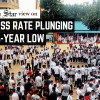How much you can pay decides what education your child gets

The compulsory education law adopted in 1990 requires that the state provides primary education up to Class 5 of acceptable quality, free of cost, to all children in Bangladesh. But the government has not accepted such an obligation for secondary education. After three decades since the primary education pledge was made, the cost of a child's education remains a heavy burden for some 80 lakh households below or close to the poverty line in the country.
A Brac Institute of Educational Development (Brac IED) study titled "Non-state actors in education" (2022), prepared for the Global Education Monitoring Report, estimated that of around 44 million students in Bangladesh (excluding those in Qawmi madrasa), 42 percent attend institutions fully supported by the state (the majority being primary schools), 38 percent go to non-government institutions assisted by the state, and 20 percent go to private institutions without support from the state. But even in state institutions, the study noted, there is substantial non-government contribution, mainly in the form of household expenditure for children's education.
The Education Watch 2023 report found that, between 2022 and 2023, a family's out-of-pocket costs per school-going child increased by 25 percent and 51 percent at the primary and secondary levels, respectively. The average annual family cost per child in 2023 was Tk 17,294 and Tk 41,424 for primary and secondary levels, respectively—about a quarter less for rural areas. Private tutoring and commercial guidebooks were major contributors to these costs.
According to the Bangladesh Bureau of Statistics (BBS), the average monthly family income was Tk 32,422 in 2022. Schooling cost is a big burden, especially for about two crore households in the country earning below-average income, especially if they have more than one school-going child.
In this context of systemic disparity, the initiative to roll out a new curriculum in 2022 proposing major changes in classroom practices and in assessing students' learning is seen by many as a partial and fragmented response, attempting to address symptoms rather than the root of the problem. The critics are concerned about the readiness of schools, teachers, students, and parents for the radical changes being attempted. In fact, the changes were justified by the authorities as a way of weaning students off private tutoring and commercial guidebooks, thus reducing household costs. However, anecdotal evidence indicates that the materials needed for the project work and the ICT access now required for students have added to family expenses, while students and teachers are still reluctant to give up private tutoring and guidebooks.
Systematic discrimination and the denial of equal opportunities characterise the education system in Bangladesh. A comprehensive national plan for quality schooling, looking at it from a rights perspective, does not exist. The target set in Education Policy 2010 to obtain education up to Class 8 by 2014 is yet to be reached. Now, in 2024, in light of the SDG 4 target, it is necessary to consider compulsory and free education of acceptable quality up to Class 10 and eventually Class 12. Yet, no such national plan exists, nor does it seem to be under consideration.
A major fault line in school provisions is between rural areas (where 70 percent of the children live) and urban localities. City slums are an exception to the pattern, where education facilities are often worse than those in rural areas. Rural schools are at a disadvantage in respect of capable and motivated teachers, adequacy of infrastructure, and availability of effective and operational digital technology. Sociocultural norms discourage girls to realise their potential, even though more of them are enrolled in school than boys.
Various Education Watch reports and other studies have documented the educational disparities affecting populations in geographically remote and ecologically disadvantaged areas (such as haors, chars, hills, and coastal areas), cultural and ethnic minorities, and children with disabilities and in especially difficult circumstances (such as street children, working children, and Dalits). The condition of these deprived categories intersect with the poverty effects and gender effects of patriarchal norms in society, which further aggravate their deprivation.
The 2010 policy envisioned a unified and equitable school education of acceptable quality for all children. However, multiple types of schooling have become entrenched in the system: mainstream Bangla medium schools (including a small elite enclave of government-run or assisted laboratory/model schools and the private ones); multiple types of madrasas as a parallel education system; and English medium schools. The education policy was not explicit about how the multiple streams could be forged into a unified system or at least brought under a framework of common national educational vision and goal. Over the last 15 years, no initiative has been taken to plan and work towards this goal.
It has been argued that three major schooling streams reflected the social class division in the country (madrasas largely serving the poor, middle and lower-middle class enrolling their children in Bangla schools, and the powerful elites patronising the English medium institutions). The diverse streams reinforced the existing class division in society.
The state did assume responsibility for most primary schools, adopted the compulsory primary education law in 1990, offered a monthly stipend to a large number of students at primary and secondary levels, and distributed free textbooks to all students of mainstream schools. These measures expanded access to education in a major way, but only partially mitigated the disparities in the system noted above. The scale of effort and effectiveness of implementation remained deficient. More significantly, expansion did not match learning outcomes, thus limiting the impact of the initiatives.
It is a no-brainer that to offer equal and inclusive opportunity for education, a state-run or state-assisted primary and a secondary school of acceptable quality must exist in every locality across the country. To attain this goal, planning and management of school education should be decentralised to each upazila, union, and city ward. The declining trend of public investment in education (in real terms), which has persisted for a decade, has to end. More importantly, use of resources has to be guided by comprehensive planning and strategies to address the various disparities and reduce the burden of costs on families.
But how will all this happen? This author and others have been advocating education leadership initiatives for transformative change in the sector. Two helpful steps would be: a) to bring school education management under the leadership of one ministry to allow coordinated and holistic development; and b) to establish a high-power statutory permanent education commission as recommended in the Education Policy 2010. These measures can work only with high-level political commitment to enable the system to work by protecting educational institutions and decision-making from partisan and short-sighted political calculations.
Dr Manzoor Ahmed is professor emeritus at Brac University, chair of Bangladesh ECD Network, adviser to Campaign for Popular Education (CAMPE), and associate editor at the International Journal of Educational Development. Views expressed in this article are the author's own.
Views expressed in this article are the author's own.
Follow The Daily Star Opinion on Facebook for the latest opinions, commentaries and analyses by experts and professionals. To contribute your article or letter to The Daily Star Opinion, see our guidelines for submission.

 For all latest news, follow The Daily Star's Google News channel.
For all latest news, follow The Daily Star's Google News channel. 











Comments